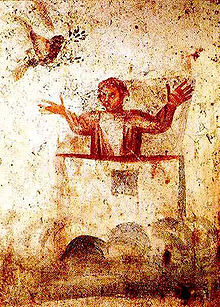
Back Оранта Bulgarian Orant Catalan Oranta Czech Orant Danish Orantenhaltung German Oranto EO Orante (tema iconográfico) Spanish Orante (icône) French Orans Hungarian ორანტა KA



Orans, a loanword from Medieval Latin orans (Latin: [ˈoː.raːns]) translated as "one who is praying or pleading", also orant or orante, as well as lifting up holy hands, is a posture or bodily attitude of prayer, usually standing, with the elbows close to the sides of the body and with the hands outstretched sideways, palms up.[1][2][3] The orans posture of prayer has a Scriptural basis in 1 Timothy 2 (1 Timothy 2:8): "I desire, then, that in every place the men should pray, lifting up holy hands without anger or argument" (NRSV).[1][2][3]
It was common in early Christianity and can frequently be seen in early Christian art, being advised by several early Church Fathers, who saw it as "the outline of the cross".[1][3] In modern times, the orans position is still preserved in Oriental Orthodoxy, as when Coptic Christian believers pray the seven canonical hours of the Agpeya at fixed prayer times.[4] The orans also occurs within parts of the Catholic, Oriental Orthodox, Eastern Orthodox, Lutheran, and Anglican liturgies, Pentecostal and charismatic worship, and the ascetical practices of some religious groups.[2][3]
- ^ a b c Couchman, Judith (5 March 2010). The Mystery of the Cross: Bringing Ancient Christian Images to Life. InterVarsity Press. p. 85. ISBN 978-0-8308-7917-5.
Because early Christians were Jewish, they naturally lifted their hands in prayer, like the veiled orans figures in the catacombs. The apostle Paul advised the earliest Christians, "I want men everywhere to lift up holy hands in prayer, without anger or disputing" (1 Tim 2:8) and early church literature indicates the widespread practice of this prayer position. In the first through third centuries, Marcus Minucius Felix, Clement of Rome, Clement of Alexandria and Tertullian either advised Christians to lift up hands in prayer, or at least mentioned the practice.
- ^ a b c Wainwright, Geoffrey (1997). For Our Salvation: Two Approaches to the Work of Christ. Wm. B. Eerdmans Publishing. p. 76. ISBN 978-0-8028-0846-2.
The piety shows itself in the informal signing of one's body with the sign of the cross, in what 1 Timothy 2:8 calls "lifting holy hands" in prayer (a gesture stretching from the orans pictures in the catacombs to modern Pentecostalism), in penitential or submissive kneeling, in reverential genuflections, in the ascetical practices suggested by the apostle Paul's athletic imagery (1 Cor. 9:24-27; 1 Tim. 6:6-16; 2 Tim. 4:7f).
- ^ a b c d "Why do we extend our arms when praying the Our Father and at other times during the Maronite anaphora?". Living Maronite. 27 November 2016. Retrieved 24 April 2022.
This is sometimes referred to as the Orans posture. The posture is explicitly directed by the presently used Maronite Qorbono. The posture has in its origins an association with prayer. It can be found in the Old Testament. In Psalm 141 we pray: "Let my prayer be counted as incense before you, and the lifting up of my hands as an evening sacrifice." The posture is referred to in the New Testament at 1 Timothy 2:8, in the instructions concerning prayer: "I desire, then, that in every place the men should pray, lifting up holy hands without anger or argument;" We see the posture in the early Church catacomb icons as depicted here. The icon perhaps gives us the best indication of why the posture is presently used in the Maronite Mass.
- ^ Dawood, Bishoy (8 December 2013). "Stand, Bow, Prostrate: The Prayerful Body of Coptic Christianity: Clarion Review". Clarion Review. Retrieved 27 July 2020.
Standing facing the East is the most frequent prayer position. The person praying usually holds his or her hands outwards in the 'orans' position, which is a common Christian position of prayer, frequently portrayed in ancient Christian art, including in Coptic iconography. At other times, hands may be kept down to the sides or held together as a sign of standing in humility before God. Some people choose to hold a cross in their hands as they stand in the orans position; in this case, the sign of the cross traced over the body ends with kissing the cross.